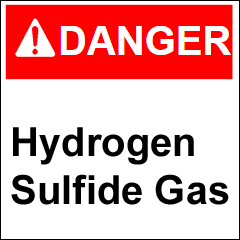Free Hydrogen Sulfide Training Awareness
11 min readExposure to low concentrations of Hydrogen sulfide Produces irritation to the thin, transparent tissue that covers the outer surface of the eyes and mucous membranes. Brief exposure to the high concentration of hydrogen sulfide may result in collapse, coma, and death from respiratory failure .hydrogen sulfide Training Awareness is intended for all employees who work in locations where hydrogen sulfide is stored, used, produced, or may be created as a result of a process. in this training awareness we will learn the harmful effects of the hydrogen sulfide and how to protect ourselves from such exposure. This awareness is also for employees who may be exposed to naturally-occurring hydrogen sulfide in natural gas operations.
When you have finished this article, you should:
- Know where hydrogen sulfide is found
- Identify some of the operations that expose employees to hydrogen sulfide
- Know how exposure occurs
- Identify hydrogen sulfide de health hazards
- Know how to prevent overexposure to hydrogen sulfide
- Understand exposure monitoring
- Identify control measures
Also Read: Hydrogen Sulfide New Regulations


What is Hydrogen Sulfide?
Hydrogen sulfide (H2S) – is an extremely hazardous, flammable, colorless, and toxic gas. Hydrogen sulfide is typically naturally occurring.
- Hydrogen sulfide is a component of natural gas and can vary in concentration
- Hydrogen sulfide is heavier than air and sinks to accumulate in confined spaces such as trenches, sewer manholes, holes in the ground, etc
- It is a gas that is recognizable by its characteristic odor of rotten eggs at low concentrations. However, its odor may not be detectable under certain changing conditions
- In the petroleum industry, when hydrogen sulfide is present in natural gas, it is often called “Sour Gas“
- Hydrogen sulfide can also take the form of industrial liquid waste
Where is Naturally Occurring Hydrogen Sulfide Found?
Awareness of the presence of hydrogen sulfide is important because it is found in a very large assortment of products. Naturally occurring hydrogen sulfide is found in:
- Crude petroleum
- Natural gas
- Volcanic gas
- Hot springs
- Bacterial breakdown of organic matter
- Human waste
- Animal waste
- Ground waste
Physical Properties
1
Physical Properties of hydrogen sulfide:


Hydrogen sulfide is a colorless gas that is about 20% heavier than air (gas @ 59°F (15°C), at 1 atmosphere of pressure)
Because it is denser than air, it can collect in low-lying areas of a work site without setting off fixed monitors. For this reason, you should always wear a personal gas monitor calibrated for hydrogen sulphide when working in areas in which you might be accidentally exposed


2
Flammability of hydrogen sulfide:


It is important to remember that hydrogen sulfide is an extremely flammable gas. Because its ignition point(428°F/250°C) is only slightly higher than that of ordinary cotton (and much lower than that of gasoline), special care must be shown when working in areas in which hydrogen sulphide may be present. In these work areas, you should use only approved power tools and non-sparking hand tools, and NEVER smoke
The Lower and Upper Explosive Limits (LEL and UEL, respectively) indicate the flammability range of a substance. In other words, the concentration of a substance in the form of a gas or vapor will cause the substance to ignite. The LEL of hydrogen sulphide is 40,000 ppm (parts per million) or 4% by volume. You should exercise extreme care when concentrations approach 10% of the LEL.Know What is Meaning of %LEL, %UEL, PID


3
Solubility of hydrogen sulfide:


Hydrogen sulfide is a highly soluble gas. It dissolves easily in water, alcohol, ether, and petroleum solvents. Hydrogensulfi de is also highly soluble in crude oil, though its solubility descends as the temperature of the liquid increases


4
The odor of hydrogen sulfide:


Hydrogen sulfide has a strong odor like rotten eggs.
The odor threshold (the lowest concentration of a chemical in the atmosphere at which it can be detected by smell) is 0.02 ppm.
However, since this number is determined in a closed laboratory setting, the actual odor threshold may vary depending on your situation and sensitivity to odor.
In addition, hydrogen sulphde has an olfactory fatigue level of 100 ppm, which means that you can become accustomed to the odor at low concentrations and quickly become unaware of it.
For these reasons, you should NEVER use odor as the sole detector for the presence of hydrogen sulphide


Locations Where Hydrogen Sulfide Can Be Found
Confined Space
A confined space has the following characteristics:
- It is not designed for humans to continuously occupy. This means there may not be ventilation, lighting, or temperature control
- It is large enough so a person can physically enter the space
- It has limited means to enter and exit
Hydrogen sulfide often is found in higher concentrations in oxygen-deficient confined space areas such as:


- Trenches
- Sewer manholes
- Pumps
- Holes in the ground
Also Read: Dangerous gases in confined spaces
Note: Buildings, pipelines & storage vessels also can have high levels of hydrogen sulfide.
Process Vessels
Hydrogen sulfide may accumulate inside containers such as Process Vessels, creating a possibly catastrophic condition. Process Vessels are storage tanks whose internal walls can either be non-coated or have a fusion-bonded epoxy coating(depending on their application) for protection against corrosive gases.
Hydrogen sulfide can react with the steel components of the internal walls of the vessel to produce iron sulfide (or pyrophoric dust) which is combustible in air and can self-ignite.
Iron sulfide burns with an almost invisible blue flame that can burn undetected until consumed, creating very dangerous working conditions and raising the temperature inside the vessel/tank up to the point of explosion if not controlled. This could be a potentially catastrophic condition at a facility refining or storing large quantities of chemicals.
To prevent iron sulfide de-generation, opened vessels shall be washed with water immediately.
Wastewater Treatment
When organic matter decomposes, hydrogen sulfide can be formed by sulfate-reducing bacteria. Low-lying areas such as those related to wastewater treatment tend to have higher concentrations of hydrogen sulfide. Some locations of hydrogen sulfide can include:
- Pump pits
- Sewers
- Chemical tanks
- Storage vessels
- Areas associated with anaerobic treatment processes e.g. wastewater treatment plants, anaerobic digestors
Petroleum Refining
In petroleum refineries, employees should be cautious due to the fact that natural gas can contain more than 25%hydrogen sulfide gas. Some sources of hydrogen sulfide in petroleum refining can include:
- Natural gas areas
- Storage tanks
- Pipeline areas
- Operations – loading/transfer areas
Other Locations
Industrial workers should be aware of hydrogen sulfide de hazards because many industrial activities involve possible exposure to H2S. Some of these activities include:
- Offshore oil platforms
- Pipeline maintenance
- Sewage treatment
- Other Locations
- Natural gas production
- Chemical plants
- Food processing
- Petroleum production and refining
- Coke oven plants
- Landfills
- Papermaking
- Mining
- Wastewater treatment plants
- Petrochemical industry
Routes of Exposure to Hydrogen Sulfide
Hydrogen sulfide can enter the body in several ways.
Inhalation through the lungs
When you breathe, hydrogen sulfide de enters the lungs. This is the most significant route of exposure.


Skin contact
Hydrogen sulfide can be absorbed directly into the skin.


Ingestion through the mouth
Hydrogen sulfide can be accidentally swallowed while eating, drinking, or smoking.


Eye contact
Vapors can be absorbed through the eyes.


Also Read: Photo of the day: Managing Risks of Exposure to Solvents in the workplace
Exposure Warnings of Hydrogen Sulfide


Hydrogen sulfide has a strong “rotten egg” smell at low concentrations that can alert you to exposure. However, long-term exposure can make you less sensitive to the smell of hydrogen sulfide.
Hydrogen sulfide de’s odor may not be detectable under certain conditions, such as:
- Prolonged exposure
- Wind direction
Despite the pungent rotten egg odor, H2S will fatigue your sense of smell rapidly. Therefore, you can not rely on the smell as a warning sign of exposure.
Exposure Limits
The Permissible Exposure Limit (PEL) to hydrogen sulfide will vary by country. Typical exposure limits in many countries are 1 part per million (ppm), for a period of no more than eight hours.
Keep in mind that parts-per-million (ppm) is a much smaller fraction than the percentage (%) when discussing the amount of gas in an environment. It might be easier to think about it this way; the percentage is simply another way of writing “parts per hundred” – thus percentage is 10,000 times greater than parts per million.
For example, an atmosphere containing 1% hydrogen sulfide gas is hardly a small amount. That’s a 10,000 ppm atmosphere, which would kill you instantly!
Note: At no time should exposure limits be exceeded!
Health Hazards – Toxicity Levels
Exposure to hydrogen sulfide poses health risks based on the concentration level and time of exposure:
Eye irritation and headaches.
Inflammation of the cornea, loss of the sense of smell, headache, respiratory tract irritation, cough, and desire of vomiting.
Respiratory difficulties, lung edema, chronic irritation to lungs, blurred vision (from 30 minutes through 8 hours exposition).
Symptoms in the central nervous system: e.g, trembling, weakness, loss of sensation in the extremities, convulsions unconsciousness (from a few minutes until 8 hours after exposure).
Fast unconsciousness (from first few breaths until 5 minutes of exposure), resulting in death if emergency help (such as CPR)is not available in the first 15 minutes of exposure.
Heart palpitations, dizziness, collapse, possible permanent brain damage, and other internal organs side effects (due to the level and time of exposure) require full medical evaluation.
Complete failure of the respiratory system and death. No resuscitation is possible (from the first breath).
Different people have varying tolerances to hydrogen sulfide and can react differently. Not
feeling any effects do not mean that you’re not experiencing them!


Always report all signs and symptoms to your supervisor immediately!
Note: The Immediately Dangerous to Life and Health (IDLH) level is well below the LEL or explosion hazard level of 40,000 ppm.
Exposure Monitoring
Exposure Monitoring is the detection (including location and concentration) of hydrogen sulfide.
Detection is essential to assess your exposure to hydrogen sulfide. The best prevention of exposure to hydrogen sulfide is to know the location of dangerous gases and their concentration. Monitoring devices are necessary to determine the presence of hydrogen sulfide. There should be constant monitoring in areas where hydrogen sulfide is stored, used, produced, or maybe created.
Note: Since hydrogen sulfide is heavier than air and tends to settle in low-lying areas, detection should include sampling for the bottom of all confined spaces and excavations!
Monitors


Personal Monitors
Employees should wear a personal monitor in areas where there is a potential for hydrogen sulfide exposure. Personal monitors should be equipped with audible and vibrating alarms, in order for you to be able to acknowledge the alarm in noisy work areas. Remember to properly calibrate your personal monitor.


Fixed Monitors
Fixed monitors should be placed in work areas where there is a potential for hydrogen sulfide release. Employees should make note of the location of the fixed monitor upon entering the work site.
Also Read: Respirators in High Hazard Environments: Worker Protection from H2S
Exposure Control Measures
Before working in an area where there may be exposure to hydrogen sulfide, it must first be determined if the hazard may be eliminated or reduced through engineering, administrative, or work practice controls.
Engineering controls
Use technological means to isolate or remove hazards from the workplace, such as:
- Continuous use of monitoring instruments
- Direct-reading instruments
- Ventilation systems
- Engineering equipment
- Enclosing or automating work procedures
Administrative Controls
Reduce or eliminate exposure by changing the duration, frequency, or severity of exposure
- Job rotation
Work Practice Controls
Reduce the likelihood of exposure to hazards by addressing the manner that the task is performed
- No eating, chewing gum, drinking, smoking, or applying cosmetics in work areas
- Wash hands, face, and body after working in a site where hydrogen sulfide is present
- Remove contaminated clothing before going home
- Use proper personal protection equipment
- Follow established procedures
- Follow good housekeeping rules
Minimum Requirements for Maintenance Activities
In an area in which you might be exposed to hydrogen sulfide, proper pre-job planning must be conducted before you start to work. These are some things you should consider:
- Coordinate all work with the local operations teams
- Thoroughly inspect the proposed work areas, prior to the approval of the work permit for the job execution
- Ask questions, so that you understand adjacent operations, interconnections, and the like before beginning work
- Work to be executed in piping systems or vessels inside process areas shall require complete Lock Out / Tag Out (LOTO), including a double block valve, drain, and vent. Prior to drain, purge, and flush as required
- During job execution, conduct continuous monitoring for the possible presence of H2S
- If H2S is detected through monitoring or the activation of a personal monitor, stop the job, immediately evacuate the area, and report the condition immediately to your supervisor, EHS, and plant management
Supervisor Responsibilities
If you are a supervisor, you must ensure that:
- Personnel have the proper Personal Protective Equipment (PPE)
- Personnel are properly trained in the use of PPE
- Personnel training is periodically refreshed per the training schedule
- PPE is maintained in serviceable condition H2S monitors (fixed and personal) have been calibrated and properly maintained following all of the manufacturer’s recommendations
- H2S-specific equipment is supplied to workers and affected visitors, including:
- Personal H2S monitors
- Emergency escape respirators
- Appropriate body, eye, face, and foot protection (chemical protection if needed)
Preventing Hydrogen Sulfide Exposure: Your Role
Upon entering a new work site for the first time, you should observe the following procedures:
- Review site safety, health policies, and procedures
- Familiarize yourself with emergency evacuation procedures and exit locations
- Review the layout of your work area and the total job site
- Locate fixed hydrogen sulfide de monitors
- Familiarize yourself with the site’s low-lying areas
To keep yourself safe remember these rules when working around hydrogen sulfide:
- Use only approved non-sparking tools and power tools/equipment that are compatible with your surroundings and safety precautions
- Observe engineering, administrative, and work practice controls
- Practice good hygiene; wash hands thoroughly and remove contaminated clothing at work
- Use and wear appropriate PPE, especially your personal monitor
- Always follow defined exposure levels, even if the level is lower than what is permissible at your facilities
- Do not smoke; hydrogen sulfide is very flammable
- Do not rely on your sense of smell to detect exposure
Note: Never enter an area containing levels above 10 ppm without a supplied-air breathing apparatus and PPE.
Report any and all hydrogen sulfide exposure symptoms to your supervisor immediately. Only trained and properly-equipped employees are allowed to attempt a rescue of fallen workers who are in need of rescue due to exposure.
What to do if you are Exposed to Hydrogen Sulfide
When hazardous levels of hydrogen sulfide are detected, employees should:
- Immediately evacuate the area
- Proceed to a designated safe area – with fresh air if possible
- Immediately call for emergency medical assistance
- If a coworker is overcome by hydrogen sulfide exposure, only qualified, trained personnel should attempt a rescue
- Wash your skin thoroughly if you have come in contact with hydrogen sulfide
Also Read: H2S Gas and how to handle its Emergency
Personal Protective Equipment
When entering any areas where the potential for H2S exposure exists, all employees shall wear the appropriate PPE. This may include the following:
- H2S personal monitors
- Respiratory Protection, such as an emergency escape pack
- Eye protection
- Hard hat
- Hearing protection
- Safety shoes
- Impervious work gloves
- Other special PPE as needed
Note: If you have any questions as to which PPE is applicable, contact your EHS Manager.
Signage


Top: DANGER
Bottom: Hydrogen Sulfide Gas
Always read signage and locate fixed monitors upon entering a facility where hydrogen sulfide may be located or produced.
It is your responsibility to read signage and locate monitors to increase your awareness of the location and concentration of hydrogen sulfide.
Also Read: Selecting the right size, type, and location of Fire Safety Signs
For more safety Resources Please Visit Safetybagresources



